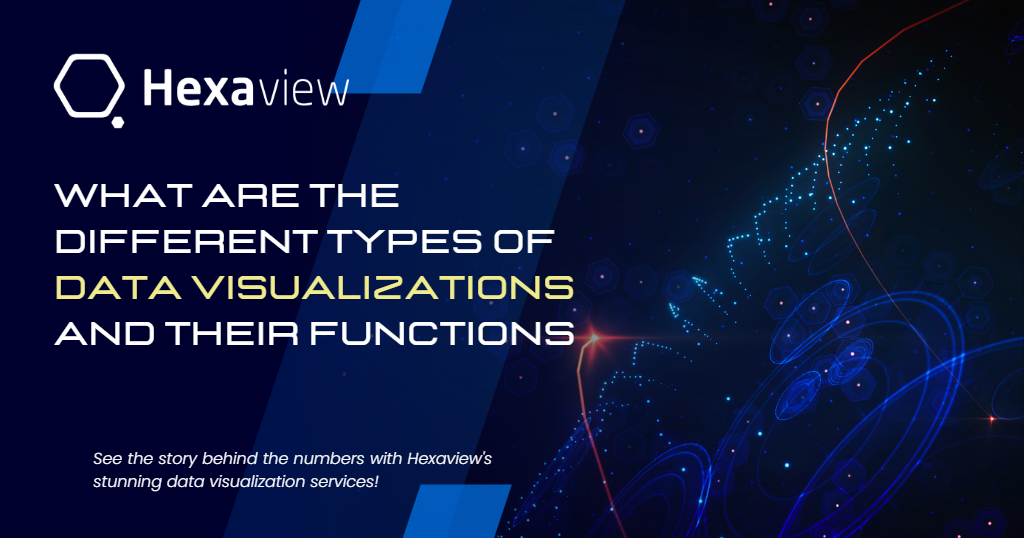Fintech
Binding seamless Technology with Finance



General Published on: Wed Apr 19 2023
Data visualization is crucial for identifying patterns and presenting results in data analytics. But what kinds of data visualization are most frequently used? Let’s explore.
Data analytics' most crucial component is data visualization services and Data visualization consulting services, sometimes known as "data viz." Using graphical elements to map raw data is a great approach to aid in pattern recognition. It helps disseminate findings in a clear, appealing manner. Also, data visualization can be a lot of fun if done effectively, even if the integrity of your data should always come first.
We gather data in ever-larger numbers, so we need a smart technique to comprehend enormous amounts of data. We frequently employ several data visualization methods in analytics to communicate complicated datasets. Do you astonish to see how applicable these different data visualization types are?
This article reviews the top and fundamental types of data visualization that every solution must include today and the broad use cases each type of data visualization best serves.
There are 5 different categories for data visualization:
Temporal data visualizations are typically used to represent a time series and are linear and one-dimensional.
There is also a sense of familiarity with temporal visuals. Newspapers frequently use temporal data visualizations to illustrate information such as quarterly changes in the housing market or gains and losses in financial reports.
Because humans know how and when to analyze temporal data, utilizing a temporal data visualization gives your consumers an advantage when viewing the data.
Visualizations of hierarchical data group together things that refer back to a parent item. When displaying a group of data, hierarchical visualizations work best, especially if the data originates from a single source (like a tree diagram).
Although they can be more complex and difficult to read, hierarchical data visualizations also have their place and time. This one is the easiest to understand because of its linear course.
Network data visualizations employ circles and lines to represent nodes and links, respectively, to represent the relationships between items visually.
Data visualizations with many dimensions have several dimensions. This kind of depiction is frequently the most colourful and arresting due to its three-dimensionality.
This is the greatest form of visual to utilize if you want to drill down and filter your data because you can segment your data in various ways to get crucial insights.
Geospatial (or spatial) visualizations, one of the earliest visualization types, overlay well-known maps with data points. Before computational analysis, geospatial data visualizations were used for navigation; therefore, they also have a long history.
There are many different data visualization styles, but you should pick the one that works best for your audience. In a corporate setting, it's crucial to pick the visualization that will enable you to get the most out of the data shown on a dashboard. Finding the right visualization for your data set, dashboard, and users can be challenging, but I hope this article will assist you in making that decision.
A line graph shows how the values of various categories change over time. It displays modifications in value for all continuous measurements of things. It depicts a general pattern that leaves little space for misunderstanding. People utilize it for a variety of business use cases because of this.
Business leaders can estimate future results using general trends. Positive changes are frequently visible when the line advances. On the other side, the line's downward movement indicates negative changes. It comes in handy when you want to simultaneously display trends for several categories.
Using line graphs, you can compare changes for multiple groups over the same period. They are useful for determining how various groups interact with one another. A company could use this kind of graph to track the evolution of sales rates for various goods and services.
You can use a column chart to compare two or more items or to compare two or more items over time. This format could display the revenue per landing page or the number of clients by the close date.
Bar graphs display data horizontally, whereas column charts display data vertically. Although both can show data changes, column charts work best with negative data.
For instance, warehouses frequently monitor how many accidents occur on the shop floor. A column chart can make the change in the number of instances below the monthly average easier to see in a presentation.
When one data label is lengthy or has more than ten things to compare, a bar graph should be used to reduce clutter.
You can use bar graphs to compare data between groups or to monitor changes over time. Bar graphs are most helpful when there are significant changes or when comparing one group to other groups.
You can plot data on a dual-axis chart using two shared y-axis and an x-axis. Three data sets are present. The other is more suited to grouping by category, while the first is a continuous set of facts. Use this graph to see whether there is a correlation between these three data sets or not.
Using a dual-axis chart, it is simple to see relationships between several data sets. These can be useful in comparing patterns as well.
The graph above, for instance, displays how many new clients this business gains each month. It also reveals how much money those clients generate for the business.
Dual-axis charts can be used to differentiate:
An area chart is a line chart with a colour or pattern drawn between the x-axis and the line. It helps illustrate part-to-whole relationships, highlighting how each sales representative contributed to annual sales. You can use it to evaluate data on both general and specific trends.
Area charts help show changes over time. They work best for big differences between data sets and help visualize big trends.
For instance, the graph above displays users by life cycle stage and date of creation.
According to a line graph, there may be more subscribers than marketing-qualified leads. But this area chart emphasizes how much bigger the number of subscribers is than any other group.
Area graphs can help your business to:
Use this chart to compare many different goods and illustrate the makeup of each item you're comparing.
A stacked chart can be used to compare proportions of multiple categories and show changes or trends over time in data.
An illustration of a waterfall chart depicts the total increase or decrease in value between two given points. Its objective is to demonstrate how a value has altered throughout time.
Instead of reflecting starting and ending values in two bars, it breaks down and displays the various unique components that make up the net change.
A waterfall chart can be used to analyze changes in value over time, contributions to final value, and identify positive/negative changes.
Another data visualization technique is a scatter plot. While the circle colour presents categories of data, the circle size represents the volume of the data. We represent the data for two variables by points against the vertical and horizontal axis.
Scatter chart is used to display and compare data points in a two-dimensional space, identifying patterns and correlations.
A scatter plot's objective is to depict the relationship between the given variables, which aids in spotting patterns or correlations in the data. Since identifying trends requires a large number of data points, scatter plots become useful when the amount of data is high.
A funnel chart is the form of data visualization people typically utilize in many business scenarios. It assists in keeping track of users in a pipeline flow; for sales, for instance, it illustrates the values that decrease as clients move through the sales funnel.
Funnel chart is used to visualize the different stages in a process and identify areas for improvement and optimization.
The breadth of the funnel shows how many users pass through each stage. It presents a sequentially ordered linear process with a quick snapshot of where people leave it.
Other major types include
Although the finest visualizations are typically the simplest, you shouldn't let that stop you from experimenting with different strategies and creating original ways to visualize data. How numerous variations and options there are, and the revelations you make will amaze you.
To have the finest data visualization services and the best data visualization consulting services through the top data visualization consulting company, then its time to look into Hexaview Technologies, Inc for efficient and advanced, and trusted transformations; with the help of our robust data analytics capabilities, you can turn your scattered data into wise conclusions.

Get 30 Mins Free
Personalized Consultancy